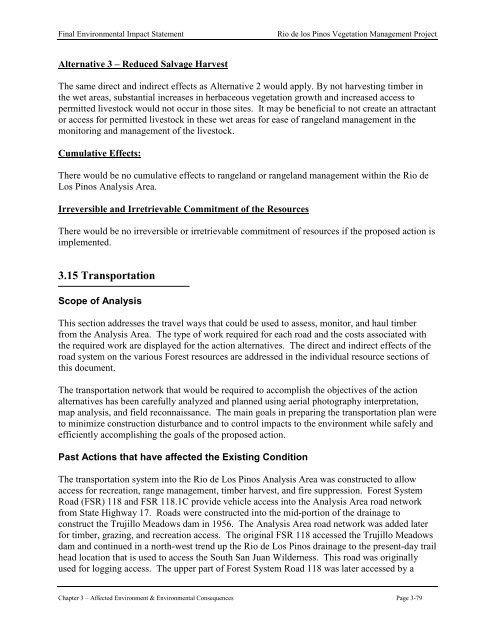Final Environmental Impact Statement Rio de los Pinos Vegetation ...
Final Environmental Impact Statement Rio de los Pinos Vegetation ...
Final Environmental Impact Statement Rio de los Pinos Vegetation ...
Create successful ePaper yourself
Turn your PDF publications into a flip-book with our unique Google optimized e-Paper software.
<strong>Final</strong> <strong>Environmental</strong> <strong>Impact</strong> <strong>Statement</strong> <strong>Rio</strong> <strong>de</strong> <strong>los</strong> <strong>Pinos</strong> <strong>Vegetation</strong> Management Project<br />
Alternative 3 – Reduced Salvage Harvest<br />
The same direct and indirect effects as Alternative 2 would apply. By not harvesting timber in<br />
the wet areas, substantial increases in herbaceous vegetation growth and increased access to<br />
permitted livestock would not occur in those sites. It may be beneficial to not create an attractant<br />
or access for permitted livestock in these wet areas for ease of rangeland management in the<br />
monitoring and management of the livestock.<br />
Cumulative Effects:<br />
There would be no cumulative effects to rangeland or rangeland management within the <strong>Rio</strong> <strong>de</strong><br />
Los <strong>Pinos</strong> Analysis Area.<br />
Irreversible and Irretrievable Commitment of the Resources<br />
There would be no irreversible or irretrievable commitment of resources if the proposed action is<br />
implemented.<br />
3.15 Transportation<br />
Scope of Analysis<br />
This section addresses the travel ways that could be used to assess, monitor, and haul timber<br />
from the Analysis Area. The type of work required for each road and the costs associated with<br />
the required work are displayed for the action alternatives. The direct and indirect effects of the<br />
road system on the various Forest resources are addressed in the individual resource sections of<br />
this document.<br />
The transportation network that would be required to accomplish the objectives of the action<br />
alternatives has been carefully analyzed and planned using aerial photography interpretation,<br />
map analysis, and field reconnaissance. The main goals in preparing the transportation plan were<br />
to minimize construction disturbance and to control impacts to the environment while safely and<br />
efficiently accomplishing the goals of the proposed action.<br />
Past Actions that have affected the Existing Condition<br />
The transportation system into the <strong>Rio</strong> <strong>de</strong> Los <strong>Pinos</strong> Analysis Area was constructed to allow<br />
access for recreation, range management, timber harvest, and fire suppression. Forest System<br />
Road (FSR) 118 and FSR 118.1C provi<strong>de</strong> vehicle access into the Analysis Area road network<br />
from State Highway 17. Roads were constructed into the mid-portion of the drainage to<br />
construct the Trujillo Meadows dam in 1956. The Analysis Area road network was ad<strong>de</strong>d later<br />
for timber, grazing, and recreation access. The original FSR 118 accessed the Trujillo Meadows<br />
dam and continued in a north-west trend up the <strong>Rio</strong> <strong>de</strong> Los <strong>Pinos</strong> drainage to the present-day trail<br />
head location that is used to access the South San Juan Wil<strong>de</strong>rness. This road was originally<br />
used for logging access. The upper part of Forest System Road 118 was later accessed by a<br />
Chapter 3 – Affected Environment & <strong>Environmental</strong> Consequences Page 3-79
















